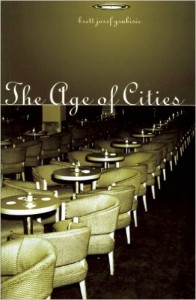 The Age of Cities
The Age of Cities
by Brett Josef Grubisic
Arsenal Pulp Press. 240 pages, $14.95
JUST AT A MOMENT when the study of gay history and literature is flourishing, social critics have declared the death of the GLBT subculture due to the rapid assimilation of gay people, especially those born after Stonewall. The last major gay civil rights battle, marriage, should be won within a generation. Does this mean that the hidden gay worlds some of us inhabited well into the 1970’s are now nothing more than artifacts to be studied? Or do stories from those years resonate with a human significance beyond time and place and circumstance? These questions are raised by Brett Josef Grubisic’s ambitious first novel, The Age of Cities.
The novel is presented as a “literary artifact” comprised of materials hidden between the covers of two old books. They are found by a student and given to his professor, who adds commentary and arranges for publication. A long manuscript relates events that took place in British Columbia between September 1958 and October 1959. By creating a narrative purportedly written in the late 1950’s, Grubisic avoids the need to bring a present-day sensibility to bear on a bygone era. He never ridicules, or even judges, the behavior of the remarkably innocent Winston Wilson, a small-town high school librarian, and the group of closeted gay men—queens of the old school—he meets on a trip to Vancouver. The manuscript is not written in the first person, but Winston is the center of consciousness through which we see the world. He is pleasant, perceptive, witty, and kind to an assortment of oddball acquaintances; but he’s no fool. Winston lives with his mother Alberta. This is the classic homosexual household circa 1959, but Alberta is not a stock character. There is a hint of thwarted prospects in her life, but she’s as witty and appealing as her son. Meanwhile, Winston deftly manages the snares of being a small-town bachelor and having encounters with teenage boys at work. He seems destined to a contented asexual life until a mysterious foot ailment takes him to Vancouver to see a podiatrist.
In Vancouver, Winston is picked up in a hotel bar by a strange man named Dickie. At this point the reader expects trouble. Instead, we get an affectionate if sad look at what the professor, who must be quite young, calls a “virtually unknown subculture.” Dickie and his heavy-drinking gang resemble a family: they quarrel but obviously care for each other. They throw a Halloween party called “Errol Flung” to observe the passing of Errol Flynn, who died in Vancouver in 1959. The guests come as characters from Flynn’s movies, an opportunity for some to wear drag. Winston willingly delves deeper and deeper into this world until, on the night of the party, the gang decides he’s ready to join them in a nearby park where men cruise for anonymous sex. After experiencing what must be his first orgasm, Winston “stared with dread into the fathomless dark of the night.” The manuscript abruptly ends at the point where many gay novels begin. We never see the foreboding darkness that lies ahead. Instead we’re offered two epilogues, each describing the same afternoon in 1965. In one, Winston has attempted to obliterate all memories of his trips to Vancouver; in the second, he continues to visit Dickie and the gang regularly, roaming in the closeted gay subculture of his time whenever he leaves home. Winston appears essentially the same in each telling. The limitation of his choices is made clear by an image of mocking crows that ends each epilogue.
For the editorial apparatus at the end of the book Grubisic must create a voice different from that of the manuscript narrator. He does this by adopting the slightly pedantic tone of an academic specializing in Canadian literature. The professor first presents additional artifacts hidden with the manuscript. These include actual photocopies of old sex manuals condemning homosexuality and a chapter called “Obscenity,” relating a scene not witnessed by Winston in which the resilient Dickie and his friends describe their first sexual encounters. The professor then gives a lengthy history of the homophobia that dominated book publishing much longer in Canada than in the U.S. A haunting picture of the Junior Homemaking book that was hollowed out to hide the manuscript speaks for all repressed writers even better than the professor: a book eviscerated to hide a manuscript that could not be published.
The Age of Cities mingles past and present with powerful effect. The history of gay men and lesbians does indeed contain real artifacts that should be brought to light. But because the hidden lives of people now gone can only be imagined, we also need storytellers who make us experience the moving, sad truth of decent people making do without many of the rights we now almost take for granted. The signal achievement of Brett Josef Grubisic in this book is the “hidden manuscript,” the beautifully realized story of Winston and his trips to the big city.
____________________________________________________________________
Daniel A. Burr is an assistant dean at the Univ. of Cincinnati College of Medicine, where he also teaches courses on literature and medicine.





